Keyword research is part and parcel of search engine optimization (SEO). Finding and using the right keywords in your content can boost your search engine results page (SERP) ranking and attract the right audiences.
Enter the Keyword Magic Tool.
In the world of SEO, does this ring a bell? Offered by no less than SEMrush, this tool lets you perform keyword research. And as the name would imply, it works like magic!
But how do you leverage this tool to avoid keyword pitfalls and kick your SEO campaign up a notch?
This page covers what you need to know about the Keyword Magic tool. Read on to learn how to address common keyword mistakes and improve SEO performance with this amazing tool.
Overview: The Use of the Keyword Magic Tool for Keyword Research
It’s no secret that Google is the most used search engine, with more than 8.5 billion searches online globally. Over 90% of online searches happen on this platform, followed by Bing at 3.23% and Yahoo at 3.27%.
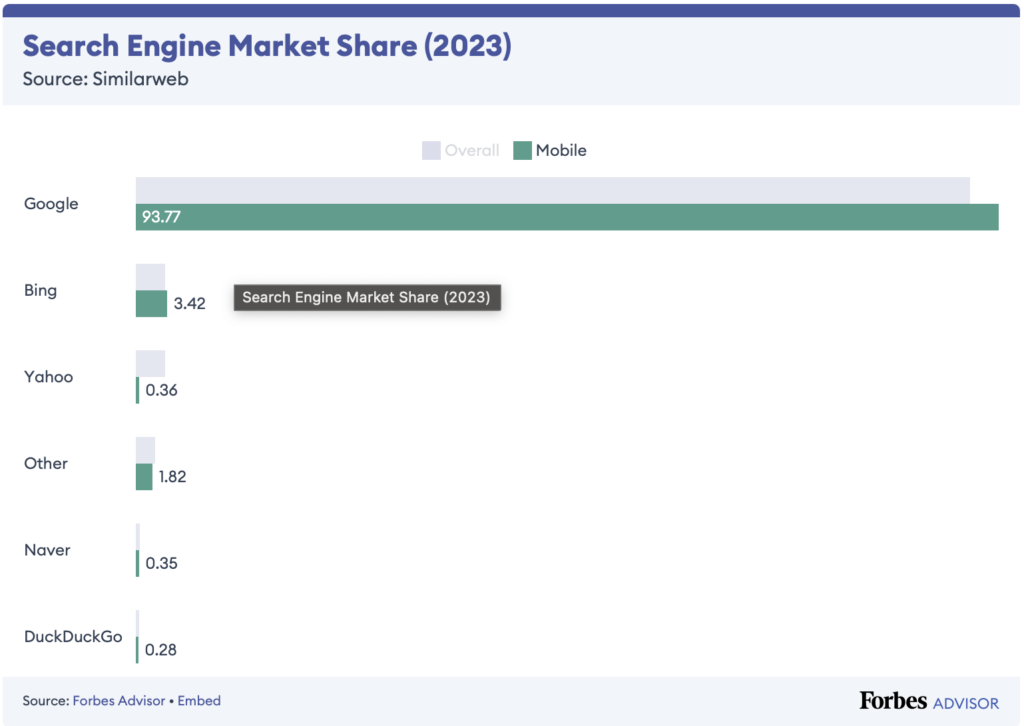
Source: Forbes
But here’s the thing: Keywords are crucial for online searches, not only for web users but also for content creators. Those who’d like to be found online should use the right words or phrases.
That’s where keyword research can help.
Simply put, keyword research entails finding words or phrases your target audiences are more likely to type into search engines when looking for information online. From there, you can integrate these keywords into your content. If lucky enough, your web pages will appear on top of SERPs for relevant searches your target users perform.
The good news? There are various SEO tools for keyword research readily available in the market. Think of Google Keyword Planner, Ahrefs’ Keyword Explorer, or Wordstream free keyword tool. If not, consider Google Related Searches, People Also Ask, and AnswerThePublic.
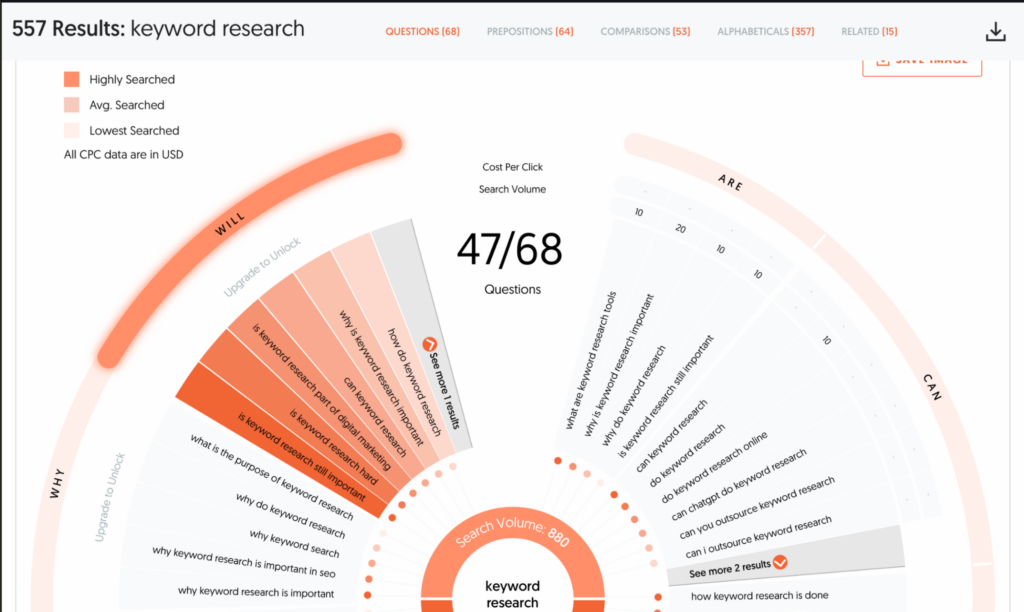
Source: AnswerThePublic
But nothing beats what Semrush has to offer as far as keyword research is concerned.
Semrush offers free and paid tools for SEO, content marketing, competitor research, PPC, and more. The Keyword Magic tool is a feature available on the platform that allows you to perform keyword research. And as the name suggests, it works magic on your SEO campaign!
Wondering how to get started with the keyword magic tool for keyword research? Follow our steps below.
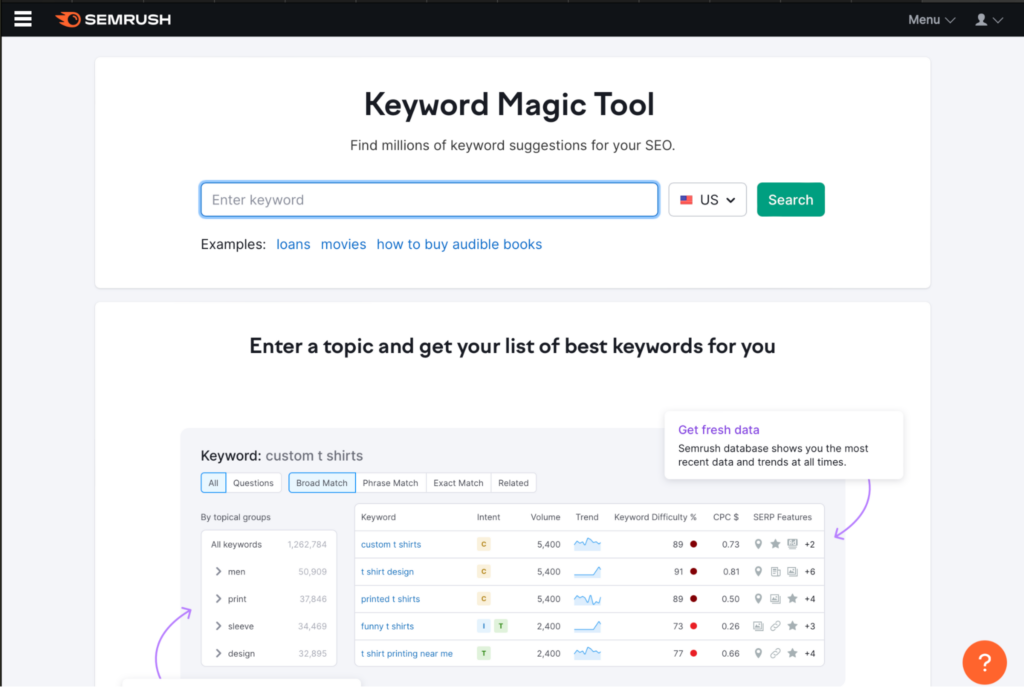
Source: Semrush
- Start by entering one of the following:
Then, select your country and click on ‘Start now.’
- Search for keyword ideas on the dashboard according to:
- Keyword variations
- Questions
Click ‘View all keywords’ or ‘Keyword Magic Tool’ in the left-hand corner.
- Obtain a list of keywords, whether:
- Broad match (all keyword ideas for seed word in all found forms and without the exact order)
- Phrase match (keywords in the exact same form as the seed word but in various orders)
- Exact match (keywords in the exact same form and the exact order)
- Related (related keywords according to similar search engine results)

Source: Screenshot by User
- Examine the list of keywords based on the following:
- Intent (search purpose)
- Volume (monthly searches)
- KD (keyword difficulty)
- Select appropriate keywords for your content creation with the following in mind:
- User intent (the purpose of the online search)
- Idea generation (topic ideas based on the keywords)
Note: Keyword research is no easy feat. It takes a strategic and comprehensive keyword analysis to find a goldmine of high-performing words or phrases.
Learn how to use this tool to address keyword mistakes in the next section.
6 SEO Mistakes: How to Address Using the Keyword Magic Tool
Now, you know what keyword research is and how the Keyword Magic Tool works. Let’s use the keyword phrase “common SEO mistakes” and see what Google comes up with.
As you can see below, Yoast takes the top SERP spot with its article, “Keyword mistakes: 8 pitfalls you can easily avoid.” If you click on it and review the content, you’ll see how strategically they used the keyword.
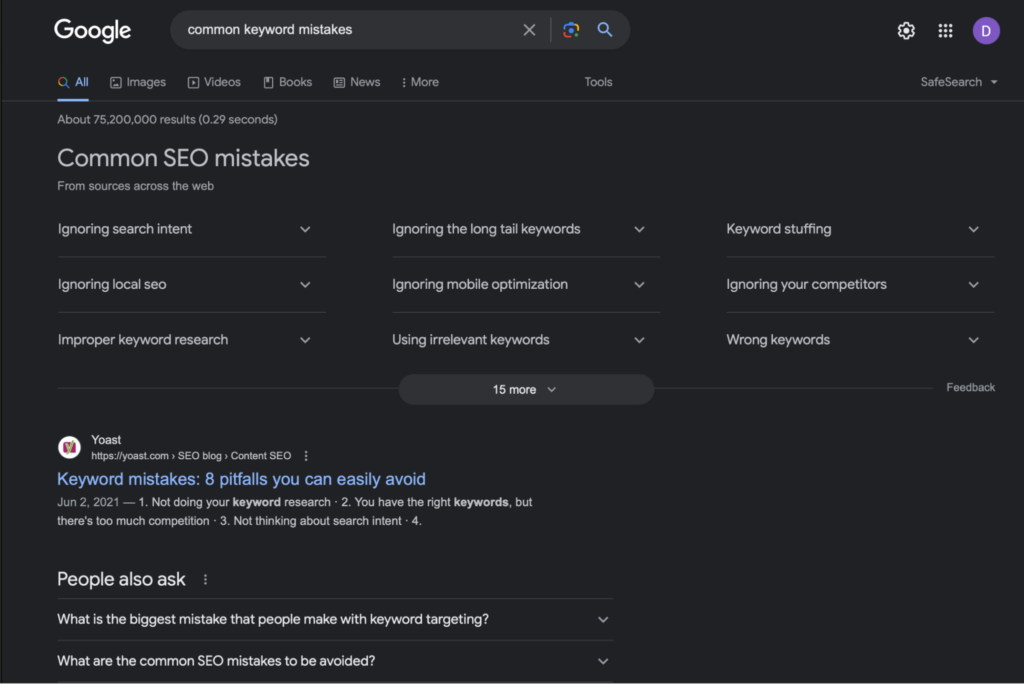
Source: Screenshot by User
Unfortunately, many individuals—even SEO experts and content writers—tend to commit keyword mistakes. Chances are, they use any phrases, don’t perform research, or don’t use keywords at all.
Here’s what they fail to realize: These common mistakes do not only help; they also harm their SEO.
That said, here are six keyword mistakes you must avoid and what you must do:
Keyword Mistake #1: Not integrating keywords in your content
Yes, a lot of content writers create various masterpieces for online posting. However, some fail to incorporate keywords into their pieces of content.
Think about it: But what good is your article if it can’t be found on the web in the first place? That isn’t a problem if you want to publish it just for yourself but not attract any target audience.
Keyword Magic Solution:
However, doing keyword research is a crucial part of SEO, especially for branding, promotion, and marketing. If you want to rank high on SERP, boost your online presence, and drive traffic to your website, you’ve got to use keywords in your content.
Keyword Mistake #2: Not conducting keyword research at all
While some use potential words or phrases for their content, others do not perform keyword research at all. That can be a recipe for SEO disaster. Remember, keywords can either help or harm your SEO.
Keyword Magic Solution:
Jim Pendergast, Senior Vice President at altLINE Sobanco, highlights the importance of keyword research in SEO.
Pendergast said, “Keyword research involves searching, analyzing, and using words or phrases your target users will most likely enter on search engines. It should always be a part of your SEO process before you can even produce and publish articles online.”
There are different methods and tools to proceed with the task, both free and for payment. One can proceed with a search engine (Google has the autocomplete pop-up with suggestions when one writes), Ahrefs, or SurferSEO. Although this task is routine, it may still give new ideas and angles. Just find the time and research. Add the task to your to-do list (a convenient day planner may help with it if the activity is not a favourite one), and you have it covered.
Keyword Mistake #3: Not focusing on long-tail keywords
Did you know that long-tail keywords are precious in SEO? They have less search volume and competition that can skyrocket your search engine ranking. Unfortunately, some tend to neglect taking advantage of these!
Keyword Magic Solution:
That said, you better boost your SEO with long-tail keywords. But first things first, note that there are three main types of keywords:
- The head keyword has a single word, a seed keyword like “Keyword.” Unfortunately, it has a high search volume and competition on the web.
- The body keyword comprises two to three words, like “Keyword Research.” However, it has lesser search volume and competition than the head keyword.
- The long-tail keyword consists of four or more phrases. “Common SEO mistakes in keyword research” is a good example. Here’s the thing: It has a lesser search volume and is more competitive than the first two types.
Keyword Mistake #4: Stuffing your content with excessive keywords
Keyword stuffing, using excessive keywords in your content, is a big no-no in SEO.
In fact, Google cites this in their SPAM policies as something you should avoid. It’s considered a black-hat tactic used to manipulate SERP rankings. Still, some engage in keyword stuffing!
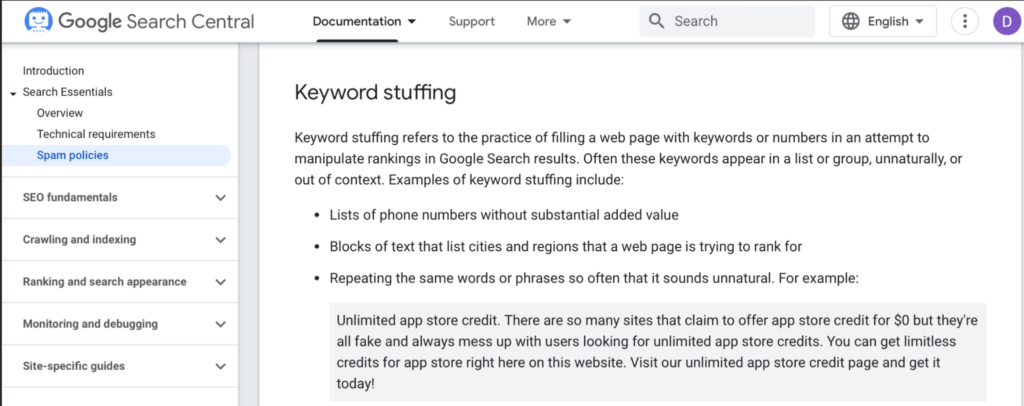
Source: Screenshot by User
Keyword Magic Solution:
Focusing on keyword quality over quantity brings more profit.
said, “This means a strategic approach in your keyword research while in the pursuit of truly targeted words or phrases. From there, use these keywords sparingly and integrate them into your content pieces strategically. And needless to say, avoid keyword stuffing at all.”
Keyword Mistake #5: Incorporating keywords all over the place
Aside from keyword stuffing, some content writers employ improper keyword placement. They end up inserting keywords in their content pieces all over the place. They should know when, where, and how to place these keywords to make them truly work for SEO.
Keyword Magic Solution:
For proper keyword placement, start by looking at the image below:
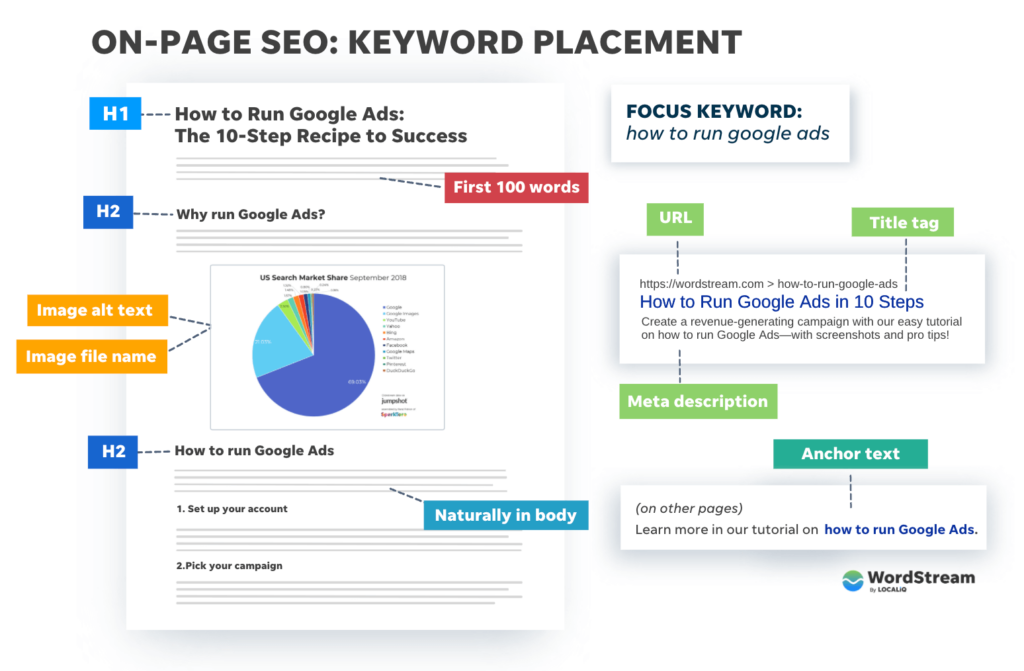
Source: Wordstream
Below are areas where you can insert those found keywords:
- The URL is the web page address showing up on SERP. It’s best to add a primary keyword.
- A Title tag is simply the title of your web page. It won’t hurt to include a primary keyword.
- The Meta description is the summary of your web page. It’s a good idea to insert a primary keyword there.
- Headings are section titles of your article. Consider adding a primary keyword.
- Subheadings are subtitles of your article. Why not insert a keyword or two?
- The Content Body should naturally include some primary and secondary keywords.
- Image Alt attribute simply describes your image. Don’t overlook adding keywords to your visuals!
Keyword Mistake #6: Not considering key attributes
Some digital marketers and even SEO specialists tend to look at keywords in a vacuum. Understand that there are crucial factors surrounding them that will help your SEO. Therefore, consider some key attributes for your keyword use or integration.
Keyword Magic Solution:
When picking and using keywords, consider the following:
- Search volume refers to the average number of monthly keyword searches over a 12-month period. The higher the KV, the more popular the keyword.
- Ranking difficulty shows how hard it is for a site to rank in SERP organically for the analyzed keyword. The lower the percentage, the higher the chance to rank in Google’s top 10.
- Relevance refers to how related the keyword is to your niche or industry. You don’t want to use the keyword “Best pizza restaurant in Arizona” for your tech website. Have the search intent in mind!
- E.E.A.T. stands for experience, expertise, authority, and trust. Keywords can attract the right audiences, but E.E.A.T. can engage and convert them into customers.
Puneet Gogia, Founder at Excel Champs, points out that higher metrics do not mean the best results. He goes, “Some options with fewer KV still make more sense, as they work for a narrow audience or have less competition. Do not sacrifice the purpose for popularity. Instead, speak out about your aim, service, product, and features, picking the most accurate terms (even if their KV and ranking difficulty do not seem high). The time passes by, rules and preferences change, so the most important is to describe yourself in the best way possible.”
Casting the Keyword Magic to Boost Your SEO
There’s no denying the power of keyword research in the SEO realm. It applies to almost all websites from any niche: The principles of SaaS SEO, e-commerce, blogs, landing pages, etc., work the same. But to cast its magic for enhancing your SEO, you’ve got to use one of the best arsenals—Keyword Magic Tool.
But here’s the trick of the trade: Leverage this tool to address common keyword mistakes and take your SEO success to the next level.
That said, beware of the six keyword mistakes discussed above and take our practical solutions to address them. More importantly, follow our crucial steps for harnessing the power of the Keyword Magic tool to perform effective keyword research.
Ultimately, boosting your search engine ranking, online visibility, and website traffic requires no magic. You must maximize the Keyword Magic tool to ensure long-term SEO success!
Would you like to optimize your SEO strategy with a team of fully certified digital marketing experts? TechWyse is here to come to the rescue! To book an appointment, call 866-208-3095 or contact us here.
